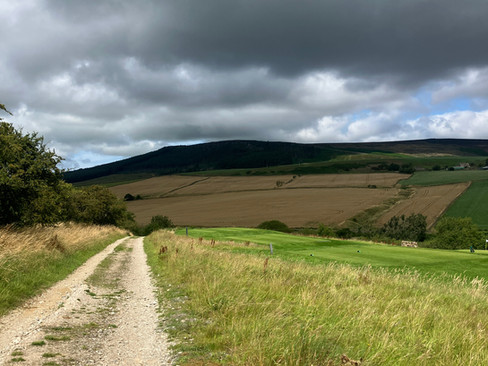Fastpacking part 2: planning your adventure
- Jenny Bushell
- Sep 6
- 4 min read
Into the Hills regulars will know that Jenny loves a fastpacking adventure. We get lots of questions about what fastpacking is, and whether it’s suitable for beginners. You can find Jenny’s first blog post about fastpacking here, which answers a lot of the questions.

In this post, I (Jenny) wanted to share a bit more about how I plan a fastpacking trip, to help you figure out what your own fastpacking adventure might look like. Before I dive in, it might be helpful to briefly revisit the ‘what is fastpacking’ question. Fastpacking is a bit of a clunky term that’s used to describe a hybrid hiking-running journey, usually over multiple days. The idea is that by running when possible (on the flats and the downs), a route can be covered more quickly than if you were purely hiking. This is desirable to some, including me, because it means you can see more in a day. I also like it because it means fewer overnight stays to pay for! To enable the running, fastpackers carry as little weight as possible. I do this by staying in hostels, pubs and B&Bs, because I don’t enjoy running carrying camping kit. But it is perfectly possible to fastpack with camping stays if your kit is fairly small and light.
When planning a journey, my process goes something like this:
1. How many days do I have available/want to journey for?
2. Is there a route that I have in mind, or have I got a blank canvas? There are hundreds of long distance routes across the UK; some are major, well-maintained and signposted paths such as our National Trails, and they vary all the way through to routes which are all but extinct. There’s a searchable database at the Long Distance Walkers’ Association (https://ldwa.org.uk/ldp/public/ldp_public_home.php). I often start with a part of the country in mind, and then narrow down the available routes depending on how long a trip I’m looking for.
3. I’ll scope out the routes I feel drawn to. I am primarily trying to figure out how runnable each route is, to help me understand how fast I’m likely to move. On a route which is flattish, on good terrain, my pace might be close to my normal easy road pace (8-10kph). If it is very hilly, or on more difficult terrain, my pace will be closer to walking (3-5kph). I do this using the Ordnance Survey map, and look at the route in detail. Does it seem to be predominantly roads, tracks, bridleways or footpaths? The first three often indicate (although not always!) good runnability, while a route that’s heavy on footpaths has the potential to be any or all of narrow, overgrown, boggy, or muddy. Of course, your chosen route doesn’t need to be a named LD path; you could just as easily make up your own route, which is what I do for our group fastpacking trips here in the Lakes.
4. Once I have a feel for my likely average pace on the route (on a fastpacking journey I usually aim to average between 5-6kph to allow for elevation, terrain and café stops) I can work out how far I can cover in a day, by thinking about how many hours per day I’d like to run for.
5. I then need to see if the route actually breaks down into sections of the right length, with accommodation options at the end. Long distance paths are often designed in sections which suit walkers, not runners, so I sometimes have to get creative with accommodation, or use local buses to hop on and off the route at the start and end of the day.
6. I also remember to factor in food – can I refuel on route, or do I need to factor in time to go to a shop, or carry food for more than one day?
7. I like to use public transport when I can, so I’ll check train times and see how much time I need to allow to get to and from the route.
8. Finally, I exercise a little bit of restraint! Running is harder on the body than hiking, so especially on a multiday trip aim to start a little smaller than you think you can do – that way you will feel great all the way.
If it all sounds complicated…it can be! But it is immensely rewarding; a pedestrian journey is in my opinion one of the best ways to experience the variety of amazing landscape and communities in the UK. I really enjoy the process of planning, figuring out my journey, and starting to understand the route before I’ve even set foot on it. I also find I’m more relaxed on the journey because I’m not trying to figure out where my next food supplies are coming from at the same time as enjoying the run.
Remember, if you want a ready-made packing list for your trip, it’s in our blog here. And if you’re keen on the fastpacking concept but you’d like some company, watch out for our next fastpacking journey on our socials and in our event list.
















Comments